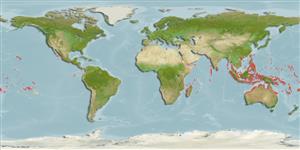Common names from other countries
Environment: milieu / climate zone / depth range / distribution range
Ecologia
marinhas; estuarina associadas(os) a recifes; intervalo de profundidade 0 - 3 m (Ref. 86942). Tropical; 25°N - 24°S
Indo-Pacific: East Africa to the Marquesan and Tuamoto islands, north to the Yaeyamas. At least one country reports adverse ecological impact after introduction.
Tamanho / Peso / Idade
Maturity: Lm ? range ? - ? cm
Max length : 47.7 cm FL macho/indeterminado; (Ref. 107958); common length : 25.0 cm TL macho/indeterminado; (Ref. 2871)
Espinhos dorsais (total): 4; Raios dorsais moles (total): 9-10; Espinhos anais 3; Raios anais moles: 8 - 9. Olive dorsally; flanks and abdomen silvery; fins hyaline (Ref. 9812). Pectoral fins with dark spot dorsally at origin (Ref. 9812).
Inhabit shallow protected sandy to muddy areas of reef flats and shallow lagoons while juveniles have been encountered in tide pools (Ref. 205). Benthopelagic (Ref. 58302). Oviparous, eggs are pelagic and non-adhesive (Ref. 205). Marketed fresh and used as live bait in pole-and-line fishing for tuna (Ref. 9812).
Life cycle and mating behavior
Maturidade | Reprodução | Desova | Ovos | Fecundidade | Larvas
Myers, R.F., 1991. Micronesian reef fishes. Second Ed. Coral Graphics, Barrigada, Guam. 298 p. (Ref. 1602)
Categoria na Lista Vermelha da IUCN (Ref. 130435)
CITES (Ref. 128078)
Not Evaluated
Ameaça para o homem
Potential pest (Ref. 6362)
Utilização humana
Pescarias: espécies comerciais; isco: occasionally
Mais informação
Nomes comunsSinónimosMetabolismoPredadoresEcotoxicologiaReproduçãoMaturidadeDesovaFecundidadeOvosDesenvolvimento dos ovos
ReferênciasAquaculturaPerfil para aquaculturaEstirpesGenéticaElectrophoresesHereditariedadeDoençasProcessamentoMass conversion
ColaboradoresFotografiasStamps, Coins Misc.SonsCiguateraVelocidadeTipo de nataçãoÁrea branquialOutras referênciasCérebrosVisão
Ferramentas
Relatórios especiais
Descarregue XML
Fontes da internet
Estimates based on models
Preferred temperature (Ref.
115969): 25.4 - 29.3, mean 28.5 (based on 2596 cells).
Phylogenetic diversity index (Ref.
82804): PD
50 = 0.5625 [Uniqueness, from 0.5 = low to 2.0 = high].
Bayesian length-weight: a=0.01175 (0.01021 - 0.01353), b=2.96 (2.92 - 3.00), in cm Total Length, based on LWR estimates for this species (Ref.
93245).
Resiliência (Ref.
120179): Médio, tempo mínimo de duplicação da população 1,4 - 4,4 anos (Preliminary K or Fecundity.).
Fishing Vulnerability (Ref.
59153): Moderate vulnerability (41 of 100).
